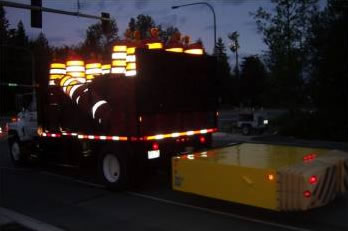Nighttime work can be dangerous, plain and simple. All sorts of hazards exist including reduced visibility, worker fatigue, lighting issues such as positioning and glare, and tired or impaired drivers. But when done safely, benefits such as lower traffic volumes and reduced delay for both motorists and construction vehicles outweigh the risks. The best two ways to ensure the safest possible nighttime work zone is to properly train all workers on safe practices in the work zone, and improve work zone visibility. In this edition of the RoadReady newsletter, we will explore what activities can be done in nighttime roadway construction, along with some safety tips to help improve the overall process.

Nighttime paving activities
Everything you do in the daytime can be done at night, with proper safety considerations and the correct level of lighting. Along with the standard safety precautions that accompany normal paving activities, there is a higher risk of worker injury at night. In order to ensure safety for both workers and drivers, some extra steps need to be taken. Let’s take a closer look.
First, train all employees on nighttime work safety, keeping in mind that some workers (like traffic control personnel) may need additional training and possibly certification. Second, have weekly safety meetings to cover any errors or incidents that may have occurred, the proper response in the future, and any anticipated changes to the work zone that may affect the safety of drivers and employees.
Additional topics to cover when training for nighttime projects include:
• Know your surroundings on the project and watch out around you
• Put clear signage for motorists in the best visibility locations
• Use changing message/arrow signs
• Space drums and cones more closely to avoid intrusions
• Conduct test drives to ensure that everything is clearly visible and operating correctly
Visibility levels
One of the greatest challenges in nighttime work is poor visibility for workers and motorists. In addition to proper training, creating a work zone with safe visibility levels can make the difference in preventing job site incidents. Let’s take a look at a couple of critical elements for improving visibility.

Safety gear can greatly affect worker visibility. The decision and maneuver distance – how long it takes a driver to notice the worker and make any path or speed changes – is over 5 times greater with reflective clothing than with regular, dark-colored – or even orange-colored – clothes. With this increased decision and maneuver distance, workers, motorists, and equipment are much less likely to have a collision – chances of damage, injury, or death are reduced.
Reflective clothing isn’t the only available technique to increase visibility at night. Flashing lights on a worker’s body or clothing, reflective tape on equipment, and especially proper work area lighting are all good ways to increase visibility.
Proper lighting at night includes several different levels and designations of lighting. In order to understand appropriate lighting levels for night work, we first need to talk about how it is measured. Lighting is typically measured by what are called “foot-candles”. One foot-candle is the illuminance cast on a 1 square foot surface by a single candle’s light.
Lighting level designations according to NCHRP Report 476, start with general lighting, which allows workers to safely move around the entire job site. This is designated as level 1, and is 5 or more foot-candles. Then, there’s active work area lighting, a higher level of light that allows for safe equipment operation and observation of the work. This is called level 2, and is 10 or more foot-candles. Finally, traffic control personnel need the most light for safety to the worker and for motorists to see and interpret their directions. This is level 3 lighting, and is 20 or more foot-candles.

Visibility and training ensure the safest possible work zone at night
There are two main ways to ensure that motorists and workers experience the safest possible nighttime work zone. First is proper safety training, and second is improving visibility throughout the work zone and especially at critical areas like traffic control workers’ stations and on any people or equipment.
Through proper training and lighting, night time construction can happen as safely as construction in the daytime. This allows contractors and agencies to take advantage of working with fewer delays for the traveling public and for construction crews to work more safely in lower volume traffic.


It is amazing how reflective material can light up even when it seems to be out of the range of the light. This must be what the article is referring to when it says that reflective surfaces are five times more visible. It can be a good clue that it is time to slow down when you see these reflections on the safety cones and barriers.